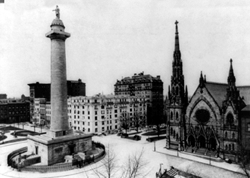
In 1980, the NTHP instituted the Main Street Program, advocating preservation in smaller cities, towns, and villages all over the United States. The Main Street Program sought to revitalize historic business districts, focusing on local economies and walkable communities, efforts that have been and continue to be quite successful.
In the continuing movement to expand the umbrella of historic preservation, preservationists realized our historic built resources were not only the unmoving structures lining streets. In 1988, the Federal Abandoned Shipwrecks Act was passed, placing emphasis on the need for maritime preservation and establishing state management of significant shipwrecks.
In the 1980s, awareness of the injustices imparted upon Native American nations throughout the U.S. was growing. In efforts to respect and recognize the autonomy of these Native American nations, the U.S. Congress passed the Native American Graves Protection and Repatriation Act (NAGPRA) in 1990. NAGPRA requires that institutions and entities receiving government funding maintain a record of Native American cultural items and human remains and return them to the nations from which they came. In 1992, NHPA was amended to provide the framework for the creation of Tribal Historic Preservation Offices (THPOs). THPOs work in much the same way SHPOs do, designating and reviewing historic resources in their respective nations.
